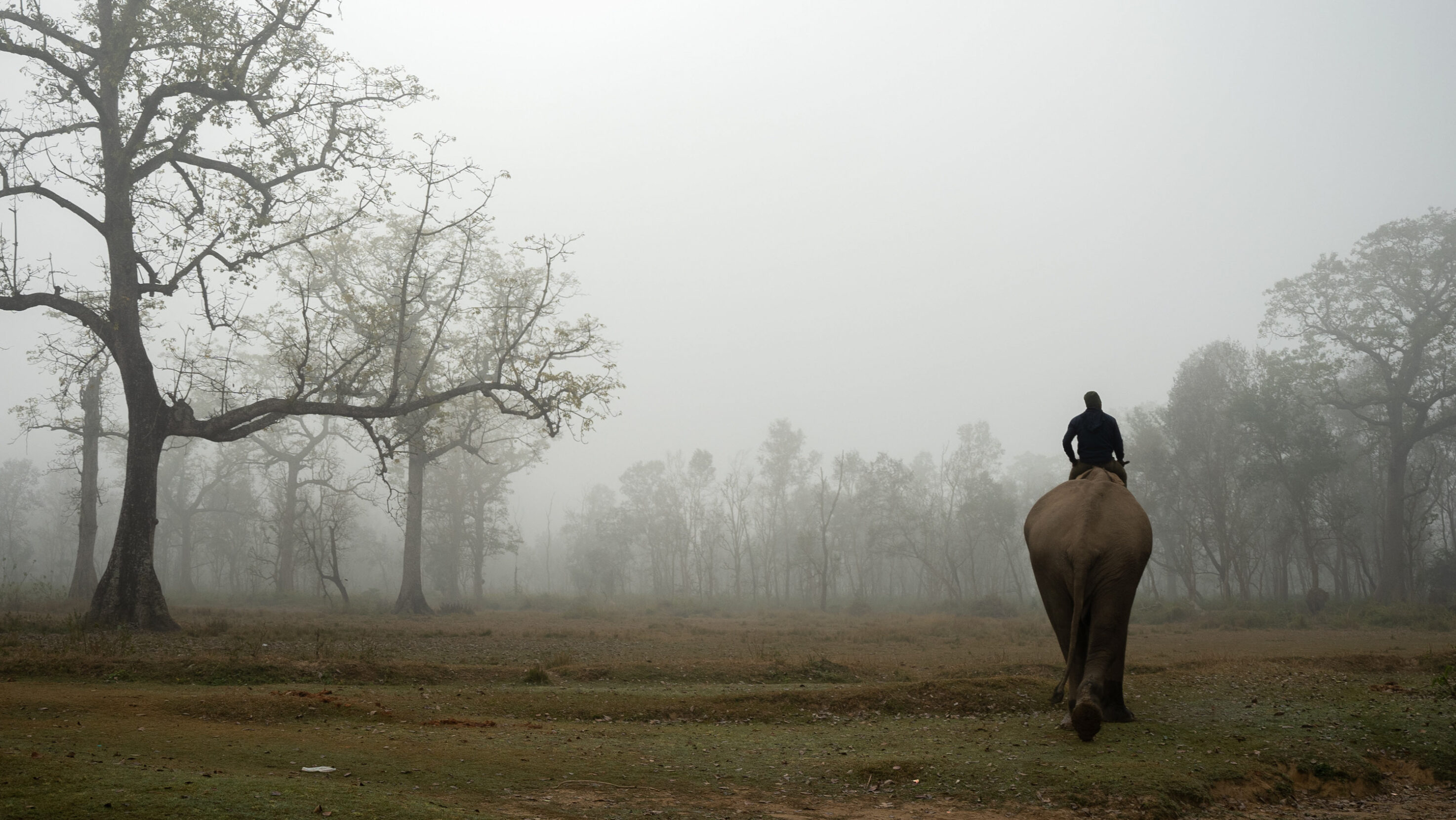READER SELECTION
This Intrepid Interlude was hand-picked by the badass members of The Alliance.
Want to vote on upcoming pitches?
This is the second installment in a four-part “Intrepid Interlude” series by Hidden Compass’s 2025 storyteller in residence, Tulsi Rauniyar. (You can read Part One here.) Earlier this year, Hidden Compass Allies voted to assign a story series on human-tiger conflict in Nepal. For Part Two, Tulsi explores this theme from the perspective of park authorities with conflicting objectives.
“Y
ou brought the tigers back. Now remove them.”
The accusation hangs in the morning air, as heavy as the mist that shrouds Bardia’s buffer zone. When Padamkala Thapa died, her family descended on the park headquarters with familiar demands: Find the tiger. Capture it. Protect us.
Eleven days later, the capture team is still trying.
~~
Five elephants emerge from the pre-dawn darkness, their massive forms barely visible through fog that limits visibility to twenty meters. It’s 6 a.m. on a December morning, and the cold cuts through multiple layers of clothing. Perched above in trees, dart specialists with tranquilizer guns are waiting.
Among them is Ajit Tumbahangphe, a senior conservation officer at the National Trust for Nature Conservation (NTNC). His neatly trimmed goatee frames a round face, and he speaks with the authority of someone who has spent nearly a decade learning to read animal behavior. The NTNC is Nepal’s oldest conservation organization, and it partners with the government to manage wildlife and support communities affected by conflict. Working alongside park officials, Ajit has developed a reputation for remaining unnaturally calm during captures that leave others on edge.
“We know the tiger is here,” he says, scanning the mist. “She is the same female from our 2021 survey. She has two cubs, over two years old now. But she seems to be very elusive. Even for a tiger.”
This is day eleven of the search for the tiger that took Padamkala Thapa’s life. Thirty people, including Nepal Army personnel, police, and park staff, have been scouring this patch of forest day and night. The work is relentless. Hours of silent tracking through forest trails, all to hear the snap of a branch or a rustle of leaves indicating the presence of the tiger, watching for fresh pugmarks in mud. The mist makes every shadow suspect.

The capture team gathers at dawn. Photo: Tulsi Rauniyar.
~~
When a tiger takes a human life in the buffer zone area, protocol demands swift action. Authorities must identify what officials refer to as the “problem tiger” — the specific animal responsible for the attack. Rangers set up camera traps around the site of the incident. They scan the forest floor for pugmarks, scratch marks on trees, and other subtle signs of movement. Then, they turn to a photographic archive of individual tigers collected during national surveys, typically conducted every four years. A tiger’s stripe pattern is unique, like a fingerprint. If the cameras capture a clear image of the returning animal, officials attempt to match it to a known individual in the archive. When there’s a match, they move in.
The forest, meanwhile, empties of its typical human presence. Grazing bans take effect immediately. Restrictions follow — no grass cutting for livestock, no entry for fodder collection. Daily routines are halted.
The capture team assembles: Veterinarians ready tranquilizer guns, mahouts atop elephants wait for an opportunity to corral the tiger. Meanwhile, spotters who know how to read a tiger’s behavior position themselves in trees, waiting for a clear shot. One dart, precisely placed, will give the team time enough to load the unconscious animal onto a truck bound for release at a different location in its habitat or, if it’s old or needs further care, to a rehabilitation center.

Members of the capture team ready their tranquilizer guns for the right moment. Photo: Tulsi Rauniyar.
~~
It took roughly 13 years for Bardia’s tiger population to grow from 18 to 125, making it the protected area with the second highest growth rate among Nepal’s tiger-bearing parks. This happened through aggressive anti-poaching efforts and habitat protection.
Yet the same numbers that draw international praise bring daily terror to those who share the land with tigers.
“What we were praised for yesterday is now what we’re being questioned for,” Ajit says. “After every attack, the community blames the park, and the pressure only builds.” Each day the tiger remains uncaught sharpens public anger. “We’re trying to protect wildlife, but we’re also trying to keep people safe.”
Without resources to manage human-wildlife conflict or compensate victims, tensions inevitably explode. In June 2022, when Bardia residents demonstrated for protection from animal attacks, police responded with gunfire, killing an 18-year-old girl in the chaos.
~~
Padmakala’s death followed a grimly familiar pattern. She had gone to graze her cattle in a nearby forest patch early that morning, accompanied by friends. Within two minutes of stepping away to relieve herself, the tiger struck.
“More than 50 percent of accidents happen like this,” Ajit explains. “People are crouched, defecating, cutting grass, collecting firewood, and in that position, we don’t look human to a tiger. We look like prey.”
According to herders who were with her, Padmakala had walked to a nearby patch moments before the attack. It was, Ajit says, another tragic case of mistaken identity, a fatal instant where survival instincts override recognition. It’s a case of mistaken identity.
~~
“Perched above in trees, dart specialists with tranquilizer guns are waiting.”
Day 12: The capture team huddles around a bonfire in the pre-dawn darkness, waiting for the mist to clear. In the Terai’s winter fog, fire looks different. Its orange glow bleeds into grey air without edges, creating a sphere of weak light that makes the forest press closer. Everyone is wrapped in scarves and thick jackets, breathing vapor even near the flames.
NTNC’s wildlife veterinarian, Bikalpa Karki, leans into the fire’s warmth. He has the permanent tan of someone who’s spent many years under jungle sun.
“Not every tiger that attacks is a man-eater,” he says quietly. “The distinction matters. A man-eater hunts humans deliberately, returns to feed. This tiger didn’t touch Padmakala’s body — clear sign she wasn’t hunting humans as prey.”
“Probably protecting her cubs.” He says carefully. “Wrong place, wrong time.”
The buffer zone where Padamkala died offers what a mother tiger needs: abundant prey, good cover, and distance from aggressive males. It also happens to be where villagers must go for their daily needs. Two competing uses of the same narrow space.
“See, when a tiger doesn’t eat the person,” Karki explains, “that means it wasn’t hunting. It was scared, surprised, protecting its cubs. These tigers, they’re not dangerous the way people think.”
The dart specialist, rifle across his knees, finally speaks. “Doesn’t matter what the science says. People want the tiger that attacks their family gone. Not moved somewhere else, gone. In a cage or buried in the ground.”
“The science is clear,” Karki continues. “If they don’t eat, they’re not going to hunt humans again. But try telling that to a family that just lost someone. You think they want to hear about animal behavior? They want their mother back.”
The fire pops in the burning sal wood, sending sparks into the mist.
~~

A lone mahout and his elephant scan the forest for signs of the tiger that killed Padamkala Thapa. Photo: Tulsi Rauniyar.
Day 13: At first light, the team reviews the camera trap footage. Multiple triggers through the night: She’s been moving in the same area, a few meters away from where the attack happened. The team mobilizes five elephants to that sector.
The strategy is to position elephants in a wide arc, then slowly close inward. The goal is to push the tiger toward the center where dart teams wait with clear shooting lanes. It’s a tactic borrowed from traditional hunting: create a funnel that narrows the animal’s options until it has nowhere to go but toward the waiting veterinarians.
The mahouts spread their elephants out, maintaining visual contact with each other. On signal, they’ll advance simultaneously, tightening the circle. The dart teams position themselves at convergence points, tranquilizer guns ready. Everyone waits. An hour passes. No movement in the undergrowth. No alarm calls from deer that might signal her presence. The elephants grow restless.
Then Ajit’s radio crackles: A wild elephant has been spotted nearby.
A wild tusker this close creates cascading problems. The mahouts must control increasingly nervous elephants while maintaining formation. Any sudden movement, any trumpeting, could alert every animal within kilometers.
“The noise would have warned her off,” Ajit observes.
They hold position for another hour, hoping. But the morning’s hope has evaporated. The wild elephant’s presence has likely pushed the tiger deeper into cover.

Deep in Bardia National Park, camera traps capture glimpses of an elusive problem tiger. Photo: Tulsi Rauniyar.
Day after day, the ritual repeats. Dawn searches. Elephants fanning through mist. Camera traps checked and rechecked. The same futile choreography of pursuit, the tiger always one step ahead, learning their patterns, adjusting her movements. For 47 days, the ritual repeats.
Then — nothing.
No pugmarks near villages. One image captures a lone cub — the cubs are at the age where they establish independence — but the mother has disappeared.
“She moved on,” Ajit says simply. “Maybe found territory deeper in the park. We monitored for weeks, no sightings, no kills, no complaints.”
The capture team packs their gear and moves to adjacent Banke National Park, where another problem tiger awaits. Padmakala’s family is left with no closure.
~~
Even if Ajit’s team captures the tiger that killed Padmakala, a new dilemma begins: Bardia already houses four tigers in captivity, each one captured after an attack. “Then what?” has become conservation’s most expensive question.
According to Ashok Ram, chief conservation officer at Bardia National Park, feeding a captive tiger costs $4,000 to $6,000 annually. Against the environment ministry’s $125 million budget, this might seem modest. But $125 million can stretch thin on a national scale, and just feeding the 17 tigers already in captivity across Nepal consumes nearly $100,000 annually, even before veterinary bills, fence repairs, and keeper salaries.
Nepal’s Tiger Conservation Action Plan (2023-2032) concedes that the increasing number of problematic tigers remains a daunting task to manage, both financially and technically. Zoos and rescue centres are already overwhelmed.
The government is grasping for solutions. Foreign zoos might accept rescued tigers as diplomatic gifts, though since 1985 Nepal has sent abroad only one tiger — a pelt and skull to a Saudi prince in 1998. Provincial governments could build zoos, officials suggest, even as Kathmandu’s central zoo struggles with its current tigers. At a recent conference, a South African manager offered a solution: Shoot all the problem tigers and bury them in an unmarked grave.
But in a country where tigers stride across temple walls and indigenous artworks, killing such creatures violates both Buddhist compassion and Hindu reverence, as well as their protected species status. Every option leads nowhere.
Meanwhile, it’s the villagers who face a difficult reality. According to them, conservation has worked too well, and now there are more tigers than the land can keep separate from people. Park officials push back, citing carrying capacity studies that suggest the habitat can technically sustain the current numbers.
“Does Nepal have too many tigers?” I ask the warden. He shakes his head. “No,” he says. “We just need to learn how to live with them better.”
~~
At Bardia’s main gate, two of the park’s four problem tigers pace behind thin metal bars. The enclosure sits awkwardly close to the park’s entrance, close enough that during feeding time, locals gather to watch the tigers tear into buffalo meat. When one tiger roars, the crowd steps back in unison, then edges forward again to get a better look. They press against the outer fence, phones raised, caught between wonder and terror.

Tiger conservation in Nepal is a success story that has drawn international praise. But the rise of human-tiger conflict presents a new problem. In Part Three, Tulsi investigates the conservation perspective. Photo: Tulsi Rauniyar.
Stay tuned for the third installment in Tulsi Rauniyar’s four-part Intrepid Interludes series, which will go live on September 24, 2025.
Tulsi Rauniyar
Tulsi Rauniyar is the 2025 Hidden Compass Storyteller in Residence. A Kathmandu-based photojournalist and documentary filmmaker, she infuses new perspectives into her work around environmental and humanitarian issues — an intersection that needs critical thinking and heart.



